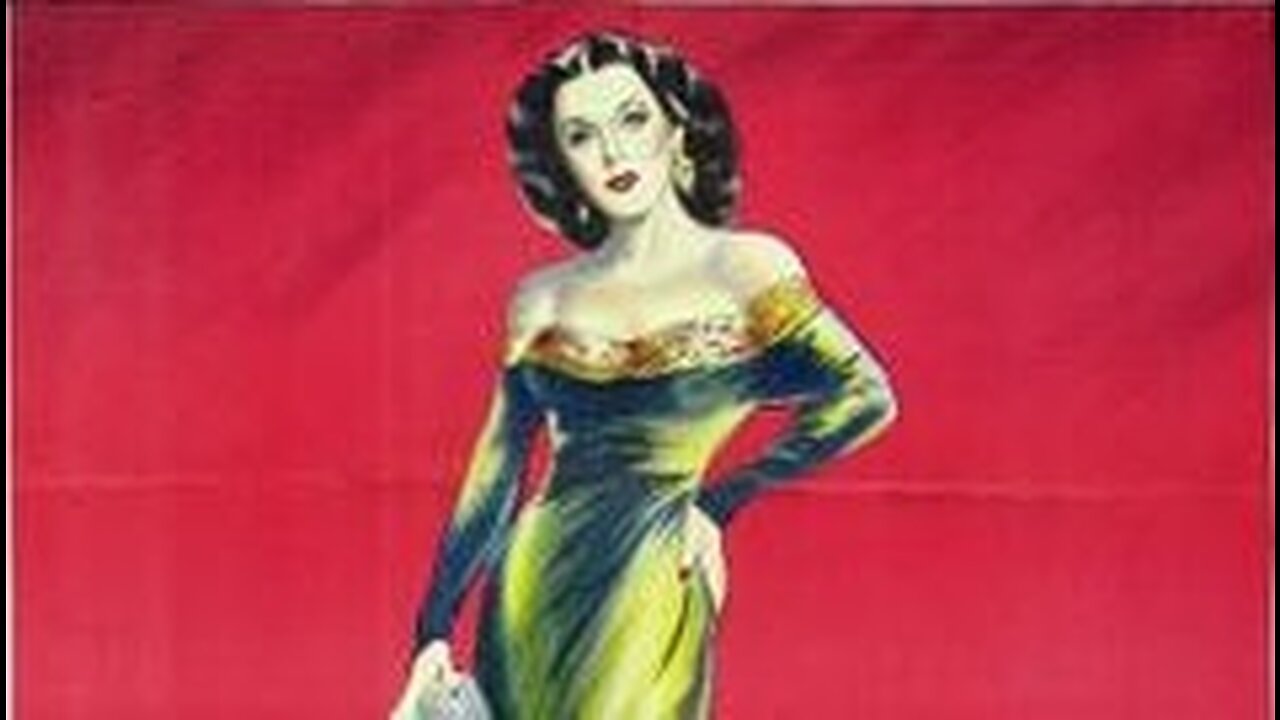Premium Only Content

Dishonored Lady: A Gripping Film Noir Drama Starring Hedy Lamarr (1947)
"Dishonored Lady" is a dramatic film released in 1947 and directed by Robert Stevenson. The film tells the story of Madeleine Damien (played by Hedy Lamarr), a successful New York City magazine editor who is struggling with inner demons and a troubled past.
Madeleine is tired of her fast-paced, high-pressure job and decides to leave her career behind in search of a new life. She moves to a small town and changes her identity, hoping to start over and leave her troubled past behind. However, she soon finds herself in a new web of complications and emotional turmoil.
As the story unfolds, Madeleine is caught up in a murder trial and becomes the prime suspect. She must fight to clear her name and prove her innocence, while also confronting her past and the personal demons that have haunted her for years.
The film features a strong performance by Hedy Lamarr, who brings depth and complexity to her portrayal of Madeleine. The supporting cast includes Dennis O'Keefe as the district attorney who becomes romantically involved with Madeleine, and John Loder as her former lover who re-enters her life.
Overall, "Dishonored Lady" is a gripping and thought-provoking film that explores themes of identity, redemption, and personal responsibility. It remains a classic of the film noir genre and is a must-see for fans of classic Hollywood cinema.
Here is the cast list for the film "Dishonored Lady" (1947):
Hedy Lamarr as Madeleine Damien
Dennis O'Keefe as David Cousins
John Loder as Felix Courtland
William Lundigan as Jack Garet
Morris Carnovsky as Dr. Richard Caleb
Natalie Schafer as Ethel Royce
Paul Harvey as Victor Kranish
Ivan Triesault as Dr. Fromm
Margaret Hamilton as Mrs. Geiger
Douglass Dumbrille as Mr. Geiger
Henry O'Neill as Mr. Stevenson
William 'Billy' Benedict as Freddie (uncredited)
James Flavin as Detective (uncredited)
Dishonored Lady (also known as Sins of Madeleine) is a 1947 American crime film directed by Robert Stevenson and starring Hedy Lamarr, Dennis O'Keefe and John Loder. It is based on the 1930 play Dishonored Lady by Edward Sheldon and Margaret Ayer Barnes. Lamarr and Loder were married when they made the film, but they divorced later in 1947.[2]
The film was released by United Artists in the United States on May 16, 1947.
Plot
Madeleine Damien is the fashion editor of a slick Manhattan magazine called Boulevard. Men are attracted to her, including boss Victor Kranish, wealthy advertiser Felix Courtland and former assistant, Jack Garet, who now works for Courtland and is blackmailing her about events from her past.
Madeleine attempts suicide and is headed toward a breakdown. She crashes her car near the home of psychiatrist Dr. Richard Caleb, who discovers her unconscious and cares for her. With Dr. Caleb's help, she realizes that she has been running away from herself just as her father may have done before he committed suicide. Under stress by her job's demands, she suddenly quits her job and disappears from the fashion scene. Under another name, she moves into a smaller apartment where she returns to painting, her earlier love. She meets her neighbor, handsome medical researcher David Cousins, who needs someone to draw the cells that he studies under the microscope. They work together closely, resulting in an excellent paper that David is invited to present at a conference. He proposes marriage, but Madeleine is hesitant because she has never told David about her troubled love life.
Madeleine's previous colleagues and Courtland learn what has become of her. Courtland surprises her at her apartment, but she rejects him. When David is away, a colleague from Boulevard contacts her for technical advice, but Madeleine wants nothing to do with the magazine. However, she consents to meet her colleague at a nightclub, and her former boss and assistant appear to meet her as well. She drinks too much and soon finds herself at Courtland's mansion by default. Courtland kisses her, but is interrupted when Garet appears. Garet had stolen a precious stone from Courtland, and he wants to try to dissuade Courtland from informing the police. Courtland refuses and noisily ejects Garet out. When Madeleine awakens, she realizes that she can leave Courtland and slips away through the rain. Garet returns and kills Courtland by bludgeoning him with a table cigarette lighter just as Courtland is calling the police.
The next day, David returns early from his conference. Madeleine learns of the murder from the newspaper and realizes that she is in trouble, but the police soon arrive to arrest her. Madeleine's false identity becomes known, and David is aghast to hear of Madeleine's past, refusing to marry her.
Madeleine is charged with the murder. During her trial, she seems catatonic, completely uninterested in the proceedings and refusing counsel. David takes the witness stand and is asked if he still loves her, and he replies affirmatively. Following this, Madeleine becomes a cooperating witness. Courtland's home safe and the theft are discovered, and David suspects that Garet may be hiding something. David confronts Garet and subdues him in a fight. Garet is arrested and confesses to the murder, and Madeleine is declared innocent.
Madeleine leaves David a letter explaining that she can not marry him until she is sure that she can really be the person whom he had believed her to be. While Madeleine is at the airport waiting for a plane, Dr. Caleb advises her that she is making a mistake by fleeing. David arrives just in time to grab Madeleine on the tarmac, and the plane departs without her as the two embrace.
Cast
Hedy Lamarr as Madeleine Damien
Dennis O'Keefe as Dr. David Cousins
John Loder as Felix Courtland
William Lundigan as Jack Garet
Morris Carnovsky as Dr. Richard Caleb
Natalie Schafer as Ethel Royce
Paul Cavanagh as Victor Kranish
Douglas Dumbrille as District Attorney O'Brien
Margaret Hamilton as Mrs. Geiger
Dewey Robinson as Jim (uncredited)
Production
Production was scheduled to begin no later than January 1945. However, problems with the Motion Picture Production Code caused a delay. The Hays Office insisted that two love affairs in the script, one in Mexico and the other in New York, might be "overloading" the picture, and also objected to the "night of sordid passion." A memo dated April 25, 1946 stated that, despite revisions, the script was unacceptable because of its gratuitous sex and references to Madeleine's unsavory family secrets. In the final film, references to Madeleine's parents were omitted completely. A character named Moreno and an affair in Mexico City were excised, and the "night of sordid passion" was not shown. All suggestions that Madeleine was a murderer, or had even contemplated murder, were also removed from the film. In the final script submitted to the Hays Office, Madeleine takes a trip hoping that the time will come when she can be with David; the reunion at the film's closing was added later.
The film was in production from early May to late July 1946 at California Studios. The sets were designed by art director Nicolai Remisoff.
The film exceeded its budget by $1.2 million and was a failure at the box office.[3]
See also
List of films in the public domain in the United States
References
"Indies $70,000,000 Pix Output". Variety: 18. 3 November 1944. Retrieved 26 July 2016.
"Dishonored Lady (1947) - Robert Stevenson | Synopsis, Characteristics, Moods, Themes and Related | AllMovie".
Balio, Tino (2009). United Artists: The Company Built by the Stars. University of Wisconsin Press. ISBN 978-0-299-23004-3. p203
External links
Wikimedia Commons has media related to Dishonored Lady (film).
Dishonored Lady at IMDb
Dishonored Lady at Rotten Tomatoes
Dishonored Lady is available for free download at the Internet Archive
Dishonored Lady at the TCM Movie Database
Dishonored Lady at AllMovie
Dishonored Lady at the American Film Institute Catalog
vte
Films directed by Robert Stevenson
Happy Ever After (1932) Falling for You (1933) Tudor Rose (1936) The Man Who Changed His Mind (1936) Jack of All Trades (1936) King Solomon's Mines (1937) Non-Stop New York (1937) Owd Bob (1938) The Ware Case (1938) Young Man's Fancy (1939) Return to Yesterday (1940) Tom Brown's School Days (1940) Back Street (1941) Joan of Paris (1942) Forever and a Day (1943) Jane Eyre (1943) Dishonored Lady (1947) To the Ends of the Earth (1948) The Woman on Pier 13 (1949) Walk Softly, Stranger (1950) My Forbidden Past (1951) The Las Vegas Story (1952) Johnny Tremain (1957) Old Yeller (1957) Darby O'Gill and the Little People (1959) Kidnapped (1960) The Absent-Minded Professor (1961) In Search of the Castaways (1962) Son of Flubber (1963) The Misadventures of Merlin Jones (1964) Mary Poppins (1964) The Monkey's Uncle (1965) That Darn Cat! (1965) The Gnome-Mobile (1967) Blackbeard's Ghost (1968) The Love Bug (1968) Bedknobs and Broomsticks (1971) Herbie Rides Again (1974) The Island at the Top of the World (1974) One of Our Dinosaurs Is Missing (1975) The Shaggy D.A. (1976)
Categories:
1947 filmsAmerican crime drama filmsAmerican films based on playsFilms based on works by Edward SheldonFilms directed by Robert StevensonFilms scored by Carmen DragonUnited Artists films1947 crime drama filmsAmerican black-and-white films1940s American films1940s English-language films
https://en.wikipedia.org/wiki/Dishonored_Lady
Hedy Lamarr (/ˈhɛdi/; born Hedwig Eva Maria Kiesler; November 9, 1914[a] – January 19, 2000) was an Austrian-born Austro-Hungarian-American film actress and inventor.[2] She was a film star during Hollywood's golden age.[3]
After a brief early film career in Czechoslovakia, including the controversial Ecstasy (1933), she fled from her first husband, a wealthy Austrian ammunition manufacturer, and secretly moved to Paris. Traveling to London, she met Metro-Goldwyn-Mayer studio head Louis B. Mayer, who offered her a movie contract in Hollywood. She became a film star with her performance in Algiers (1938).[4] Her MGM films include Lady of the Tropics (1939), Boom Town (1940), H.M. Pulham, Esq. (1941), and White Cargo (1942). Her greatest success was as Delilah in Cecil B. DeMille's Bible-inspired Samson and Delilah (1949).[5] She also acted on television before the release of her final film, The Female Animal (1958). She was honored with a star on the Hollywood Walk of Fame in 1960.
At the beginning of World War II, she and avant-garde composer George Antheil developed a radio guidance system for Allied torpedoes that used spread spectrum and frequency hopping technology to defeat the threat of jamming by the Axis powers.[6]
Early life
Lamarr was born Hedwig Eva Maria Kiesler in 1914 in Vienna, the only child of Gertrud "Trude" Kiesler (née Lichtwitz) and Emil Kiesler.
Her father, Emil, was born to a Galician-Jewish family in Lemberg in the Austrian part of the Austro-Hungarian Empire (now Lviv in Ukraine) and was, in the 1920s, deputy director of Wiener Bankverein,[7][8] and in the end of his life a director at the united Creditanstalt-Bankverein.[9][10][11] Trude, her mother, a pianist and Budapest native, had come from an upper-class Hungarian-Jewish family. She had converted to Catholicism and was described as a "practicing Christian" who raised her daughter as a Christian, although Hedy was not formally baptized at the time.[9]: 8
As a child, Lamarr showed an interest in acting and was fascinated by theatre and film. At the age of 12, she won a beauty contest in Vienna.[12] She also began to associate invention with her father, who would take her out on walks, explaining how technology functioned.[13][14]
European film career
Early work
Lamarr was taking acting classes in Vienna when one day, she forged a note from her mother and went to Sascha-Film and was able to get herself hired as a script girl. While there, she was able to get a role as an extra in Money on the Street (1930), and then a small speaking part in Storm in a Water Glass (1931). Producer Max Reinhardt then cast her in a play entitled The Weaker Sex, which was performed at the Theater in der Josefstadt. Reinhardt was so impressed with her that he brought her with him back to Berlin.[15]
However, she never actually trained with Reinhardt or appeared in any of his Berlin productions. Instead, she met the Russian theatre producer Alexis Granowsky, who cast her in his film directorial debut, The Trunks of Mr. O.F. (1931), starring Walter Abel and Peter Lorre.[16] Granowsky soon moved to Paris, but Lamarr stayed in Berlin and was given the lead role in No Money Needed (1932), a comedy directed by Carl Boese.[17] Lamarr then starred in the film which made her internationally famous.
Ecstasy
Lamarr in a 1934 publicity photo with the name "Heddie Kietzler"
In early 1933, at age 18, Lamarr was given the lead in Gustav Machatý's film Ecstasy (Ekstase in German, Extase in Czech). She played the neglected young wife of an indifferent older man.
The film became both celebrated and notorious for showing Lamarr's face in the throes of orgasm as well as close-up and brief nude scenes. Lamarr claimed she was "duped" by the director and producer, who used high-power telephoto lenses, but other people related to the movie contested her claims.[18][b][19]
Although she was dismayed and now disillusioned about taking other roles, the film gained world recognition after winning an award at the Venice Film Festival.[20] Throughout Europe, it was regarded an artistic work. In America it was considered overly sexual and received negative publicity, especially among women's groups.[18] It was banned there and in Germany.[21]
Withdrawal
Lamarr played a number of stage roles, including a starring one in Sissy, a play about Empress Elisabeth of Austria produced in Vienna. It won accolades from critics.[22] Admirers sent roses to her dressing room and tried to get backstage to meet her. She sent most of them away, including a man who was more insistent, Friedrich Mandl.[18] He became obsessed with getting to know her.[23]
Mandl was an Austrian military arms merchant and munitions manufacturer who was reputedly the third-richest man in Austria. She fell for his charming and fascinating personality, partly due to his immense financial wealth.[21] Her parents, both of Jewish descent, did not approve, due to Mandl's ties to Italian fascist leader Benito Mussolini, and later, German Führer Adolf Hitler, but they could not stop the headstrong Lamarr.[18]
On August 10, 1933, Lamarr married Mandl at the Karlskirche. She was 18 years old and he was 33. In her alleged autobiography Ecstasy and Me, she described Mandl as an extremely controlling husband who strongly objected to her simulated orgasm scene in Ecstasy and prevented her from pursuing her acting career. She claimed she was kept a virtual prisoner in their castle home,[21] Schloss Schwarzenau.[citation needed]
Hedy Lamarr, 1944
Mandl had close social and business ties to the Italian government, selling munitions to the country,[9] and although like Hedy, his own father was Jewish, had ties to the Nazi regime of Germany, as well. Lamarr wrote that the dictators of both countries attended lavish parties at the Mandl home. Lamarr accompanied Mandl to business meetings, where he conferred with scientists and other professionals involved in military technology. These conferences were her introduction to the field of applied science and nurtured her latent talent in science.[24]
Lamarr's marriage to Mandl eventually became unbearable, and she decided to separate herself from both her husband and country in 1937. In her alleged autobiography, she wrote that she disguised herself as her maid and fled to Paris, but by other accounts, she persuaded Mandl to let her wear all of her jewelry for a dinner party, then disappeared afterward.[25] She writes about her marriage:
I knew very soon that I could never be an actress while I was his wife. ... He was the absolute monarch in his marriage. ... I was like a doll. I was like a thing, some object of art which had to be guarded—and imprisoned—having no mind, no life of its own.[26]
Hollywood career
Louis B. Mayer and MGM
Sigrid Gurie (left) and Hedy Lamarr (right) were Charles Boyer's leading ladies in Algiers (1938)
After arriving in London[27] in 1937, she met Louis B. Mayer, head of MGM, who was scouting for talent in Europe.[28] She initially turned down the offer he made her (of $125 a week), but then booked herself onto the same New York bound liner as him, and managed to impress him enough to secure a $500 a week contract. Mayer persuaded her to change her name to Hedy Lamarr (to distance herself from her real identity, and "the Ecstasy lady" reputation associated with it)[25], choosing the surname in homage to the beautiful silent film star, Barbara La Marr, on the suggestion of his wife, who admired La Marr. He brought her to Hollywood in 1938 and began promoting her as the "world's most beautiful woman".[29]
Mayer loaned Lamarr to producer Walter Wanger, who was making Algiers (1938), an American version of the French film, Pépé le Moko (1937). Lamarr was cast in the lead opposite Charles Boyer. The film created a "national sensation", says Shearer.[9]: 77 She was billed as an unknown but well-publicized Austrian actress, which created anticipation in audiences. Mayer hoped she would become another Greta Garbo or Marlene Dietrich.[9]: 77 According to one viewer, when her face first appeared on the screen, "everyone gasped ... Lamarr's beauty literally took one's breath away."[9]: 2
In future Hollywood films, she was invariably typecast as the archetypal glamorous seductress of exotic origin. Her second American film was to be I Take This Woman, co-starring with Spencer Tracy under the direction of regular Dietrich collaborator Josef von Sternberg. Von Sternberg was fired during the shoot, replaced by Frank Borzage. The film was put on hold, and Lamarr was put into Lady of the Tropics (1939), where she played a mixed-race seductress in Saigon opposite Robert Taylor. She returned to I Take This Woman, re-shot by W. S. Van Dyke. The resulting film was a flop.
Clark Gable and Lamarr in Comrade X (1940)
Far more popular was Boom Town (1940) with Clark Gable, Claudette Colbert and Spencer Tracy; it made $5 million.[30] MGM promptly reteamed Lamarr and Gable in Comrade X (1940), a comedy film in the vein of Ninotchka (1939), which was another hit.
Lamarr was teamed with James Stewart in Come Live with Me (1941), playing a Viennese refugee. Stewart was also in Ziegfeld Girl (1941), where Lamarr, Judy Garland and Lana Turner played aspiring showgirls - a big success.[30]
Lamarr was top-billed in H. M. Pulham, Esq. (1941), although the film's protagonist was the title role played by Robert Young. She made a third film with Tracy, Tortilla Flat (1942). It was successful at the box office, as was Crossroads (1942) with William Powell.
Lamarr played the exotic Arab seductress[31] Tondelayo in White Cargo (1942), top billed over Walter Pidgeon. It was a huge hit. White Cargo contains arguably her most memorable film quote, delivered with provocative invitation: "I am Tondelayo. I make tiffin for you?" This line typifies many of Lamarr's roles, which emphasized her beauty and sensuality while giving her relatively few lines. The lack of acting challenges bored Lamarr. She reportedly took up inventing to relieve her boredom.[32]
She was reunited with Powell in a comedy The Heavenly Body (1944), then was borrowed by Warner Bros for The Conspirators (1944). This was an attempt to repeat the success of Casablanca (1943), and RKO borrowed her for a melodrama Experiment Perilous (1944).
Lamarr in Her Highness and the Bellboy (1945)
Back at MGM Lamarr was teamed with Robert Walker in the romantic comedy Her Highness and the Bellboy (1945), playing a princess who falls in love with a New Yorker. It was very popular, but would be the last film she made under her MGM contract.[33]
Her off-screen life and personality during those years was quite different from her screen image. She spent much of her time feeling lonely and homesick. She might swim at her agent's pool, but shunned the beaches and staring crowds. When asked for an autograph, she wondered why anyone would want it. Writer Howard Sharpe interviewed her and gave his impression:
Hedy has the most incredible personal sophistication. She knows the peculiarly European art of being womanly; she knows what men want in a beautiful woman, what attracts them, and she forces herself to be these things. She has magnetism with warmth, something that neither Dietrich nor Garbo has managed to achieve.[18]
Author Richard Rhodes describes her assimilation into American culture:
Of all the European émigrés who escaped Nazi Germany and Nazi Austria, she was one of the very few who succeeded in moving to another culture and becoming a full-fledged star herself. There were so very few who could make the transition linguistically or culturally. She really was a resourceful human being–I think because of her father's strong influence on her as a child.[34]
Lamarr also had a penchant for speaking about herself in the third person.[35]
Wartime fundraiser
Lamarr wanted to join the National Inventors Council, but was reportedly told by NIC member Charles F. Kettering and others that she could better help the war effort by using her celebrity status to sell war bonds.[36][37]
She participated in a war bond-selling campaign with a sailor named Eddie Rhodes. Rhodes was in the crowd at each Lamarr appearance, and she would call him up on stage. She would briefly flirt with him before asking the audience if she should give him a kiss. The crowd would say yes, to which Hedy would reply that she would if enough people bought war bonds. After enough bonds were purchased, she would kiss Rhodes and he would head back into the audience. Then they would head off to the next war bond rally.[38]
Producer
Victor Mature and Lamarr in Samson and Delilah (1949)
After leaving MGM in 1945, Lamarr formed a production company with Jack Chertok and made the thriller The Strange Woman (1946). It went over budget and only made minor profits.[39]
She and Chertok then made Dishonored Lady (1947), another thriller starring Lamarr, which also went over budget - but was not a commercial success. She tried a comedy with Robert Cummings, Let's Live a Little (1948).
Later films
Lamarr enjoyed her biggest success playing Delilah against Victor Mature as the Biblical strongman in Cecil B. DeMille's Samson and Delilah, the highest-grossing film of 1950. The film also won two Oscars.[21]
Lamarr returned to MGM for a film noir with John Hodiak, A Lady Without Passport (1950), which flopped. More popular were two pictures she made at Paramount, a Western with Ray Milland, Copper Canyon (1950), and a Bob Hope spy spoof, My Favorite Spy (1951).
With John Hodiak in A Lady Without Passport (1950)
Her career went into decline. She went to Italy to play multiple roles in Loves of Three Queens (1954), which she also produced. However she lacked the experience necessary to make a success of such an epic production, and lost millions of dollars when she was unable to secure distribution of the picture.
She was Joan of Arc in Irwin Allen's critically panned epic, The Story of Mankind (1957) and did episodes of Zane Grey Theatre ("Proud Woman") and Shower of Stars ("Cloak and Dagger"). Her last film was a thriller The Female Animal (1958).
Lamarr was signed to act in the 1966 film Picture Mommy Dead,[40] but was let go when she collapsed during filming from nervous exhaustion.[41] She was replaced in the role of Jessica Flagmore Shelley by Zsa Zsa Gabor.
Inventor
Further information: Frequency-hopping spread spectrum
System-search.svg
This section's factual accuracy is disputed. Relevant discussion may be found on Talk:Hedy Lamarr. Please help to ensure that disputed statements are reliably sourced. (October 2022) (Learn how and when to remove this template message)
Although Lamarr had no formal training and was primarily self-taught, she tinkered in her spare time on various hobbies and ideas, which included a traffic stoplight and a tablet that would dissolve in water to create a carbonated drink. The beverage was unsuccessful; Lamarr herself said it tasted like Alka-Seltzer.[32]
Copy of U.S. patent for "Secret Communication System"
During World War II, Lamarr read that radio-controlled torpedoes[42] had been proposed. However, an enemy might be able to jam such a torpedo's guidance system and set it off course.[43] When discussing this with her friend the composer and pianist George Antheil, the idea was raised that a frequency-hopping signal might prevent the torpedo's radio guidance system from being tracked or jammed. Antheil succeeded by synchronizing a miniaturized player piano mechanism with radio signals.[34] Antheil sketched out the idea for the frequency-hopping system, which was to use a perforated paper tape which actuated pneumatic controls (as was already used in player pianos).
Antheil was introduced to Samuel Stuart Mackeown, a professor of radio-electrical engineering at Caltech, whom Lamarr then employed for a year to actually implement the idea.[44] Lamarr hired the Los Angeles legal firm of Lyon & Lyon to search for prior knowledge, and to craft the application[45] for the patent[46][47] which was granted as U.S. Patent 2,292,387 on August 11, 1942, under her married name Hedy Kiesler Markey.[48] In 1997, Lamarr and Antheil received the Electronic Frontier Foundation Pioneer Award and the Bulbie Gnass Spirit of Achievement Bronze Award,[49] given to individuals whose creative lifetime achievements in the arts, sciences, business, or invention fields have significantly contributed to society.[50] In 2014, Lamarr and Antheil were posthumously inducted into the National Inventors Hall of Fame.[51]
Neither the US Navy nor that of any other nation were using radio-controlled torpedoes at the time, and electro-mechanical devices were soon to be made obsolete by purely electronic controls.[52] Furthermore, spread-spectrum frequency-hopping was not a completely new idea: as early as 1899, Guglielmo Marconi had experimented with frequency-selective reception in an attempt to minimize radio interference;[53] it in the first quarter of the 20th century, Nikola Tesla had written extensively about; in 1929, the Polish engineer and inventor Leonard Danilewicz further elaborated on the idea; and, in 1932, U.S. Patent 1869659A was issued to the Dutch inventor William Broertjes[54] for his electromechanical device to encrypt radio transmissions by using frequency-hopping.
Although the U.S. Navy did not adopt the technology until the 1960s,[55] the principles of their work are incorporated into Bluetooth and GPS technology and are similar to methods used in legacy versions of CDMA and Wi-Fi.[56][57][58][dubious – discuss]
Later years
Lamarr became a naturalized citizen of the United States at age 38 on April 10, 1953. Her alleged autobiography, Ecstasy and Me, was published in 1966. She said on TV that it was not written by her, and much of it was fictional.[59] Lamarr later sued the publisher, saying that many details were fabricated by its ghost writer, Leo Guild.[60][61] Lamarr, in turn, was sued by Gene Ringgold, who asserted that the book plagiarized material from an article he had written in 1965 for Screen Facts magazine.[62]
In the late 1950s, Lamarr designed and, with then-husband W. Howard Lee, developed the Villa LaMarr ski resort in Aspen, Colorado.[63][64]
In 1966, Lamarr was arrested in Los Angeles for shoplifting. The charges were eventually dropped. In 1991, she was arrested on the same charge in Florida, this time for stealing $21.48 worth of laxatives and eye drops.[65] She pleaded no contest to avoid a court appearance, and the charges were dropped in return for her promise to refrain from breaking any laws for a year.[66]
The 1970s was a decade of increasing seclusion for Lamarr. She was offered several scripts, television commercials, and stage projects, but none piqued her interest. In 1974, she filed a $10 million lawsuit against Warner Bros., claiming that the running parody of her name ("Hedley Lamarr") in the Mel Brooks comedy Blazing Saddles infringed her right to privacy. Brooks said he was flattered; the studio settled out of court for an undisclosed nominal sum and an apology to Lamarr for "almost using her name". Brooks said that Lamarr "never got the joke".[67][68] With her eyesight failing, Lamarr retreated from public life and settled in Miami Beach, Florida, in 1981.[9]
A large Corel-drawn image of Lamarr won CorelDRAW's yearly software suite cover design contest in 1996. For several years, beginning in 1997, it was featured on boxes of the software suite. Lamarr sued the company for using her image without her permission. Corel countered that she did not own rights to the image. The parties reached an undisclosed settlement in 1998.[69][70]
For her contribution to the motion picture industry, Lamarr has a star on the Hollywood Walk of Fame at 6247 Hollywood Blvd[71][72] adjacent to Vine Street where the walk is centered.
Lamarr became estranged from her older son, James Lamarr Loder, when he was 12 years old. Their relationship ended abruptly, and he moved in with another family. They did not speak again for almost 50 years. Lamarr left James Loder out of her will, and he sued for control of the US$3.3 million estate left by Lamarr in 2000.[73] He eventually settled for US$50,000.[74]
Seclusion
In the last decades of her life, the telephone became Lamarr's only means of communication with the outside world, even with her children and close friends. She often talked up to six or seven hours a day on the phone, but she spent hardly any time with anyone in person in her final years.
Death
Memorial to Hedy Lamarr at Vienna's Central Cemetery (Group 33G, Thumb n°80)
Lamarr died in Casselberry, Florida,[75] on January 19, 2000, of heart disease, aged 85.[9] Her son Anthony Loder spread her ashes in Austria's Vienna Woods in accordance with her last wishes.[76]
In 2014 a memorial to Lamarr was unveiled in Vienna's Central Cemetery.[77]
Awards and tributes
Hedy Lamarr was honored with a star on the Hollywood Walk of Fame in 1960.[78]
In 1939, Lamarr was selected the "most promising new actress" of 1938 in a poll of area voters conducted by Philadelphia Record film critic.[79] British moviegoers voted Hedy Lamarr the year's 10th best actress, for her performance in Samson and Delilah in 1951.[80]
The British drag queen Foo Foo Lamarr (born Francis Pearson, 1937–2003) originally took his surname from the actress when embarking on a performing career.[81]
In 1997, Lamarr and George Antheil were jointly honored with the Electronic Frontier Foundation's Pioneer Award[82] and Lamarr also was the first woman to receive the Invention Convention's BULBIE Gnass Spirit of Achievement Award, known as the "Oscars of inventing".[83][84] The following year, Lamarr's native Austria awarded her the Viktor Kaplan Medal of the Austrian Association of Patent Holders and Inventors.[85]
In 2006, the Hedy-Lamarr-Weg was founded in Vienna Meidling (12th District), named after the actress.
In 2013, the IQOQI installed a quantum telescope on the roof of the University of Vienna, which they named after her in 2014.[86]
In 2014, Lamarr was posthumously inducted into the National Inventors Hall of Fame for frequency-hopping spread spectrum technology.[87] The same year, Anthony Loder's request that the remaining ashes of his mother should be buried in an honorary grave of the city of Vienna was realized. On November 7, her urn was buried at the Vienna Central Cemetery in Group 33 G, Tomb No. 80, not far from the centrally located presidential tomb.[88][89]
On November 9, 2015, Google honored her on the 101st anniversary of her birth with a doodle.[90]
On August 27, 2019, an asteroid was named after her: 32730 Lamarr.[91][92]
Marriages and children
Lamarr was married and divorced six times and had three children:
Friedrich Mandl (married 1933–1937), chairman of the Hirtenberger Patronen-Fabrik[93]
Gene Markey (married 1939–1941), screenwriter and producer. She adopted a child during her marriage with Markey. Lamarr and Markey lived at 2727 Benedict Canyon Drive in Beverly Hills, California during their marriage.[94]
John Loder (married 1943–1947), actor. The two had a daughter who married Larry Colton, a writer and former baseball player and a son who worked for illustrator James McMullan.[95] Anthony Loder was featured in the 2004 documentary film Calling Hedy Lamarr.[76]
Ernest "Ted" Stauffer (married 1951–1952), nightclub owner, restaurateur, and former bandleader
W. Howard Lee (married 1953–1960), a Texas oilman (who later married film actress Gene Tierney)
Lewis J. Boies (married 1963–1965), Lamarr's divorce lawyer
Following her sixth and final divorce in 1965, Lamarr remained unmarried for the last 35 years of her life.
Throughout her life, Lamarr claimed that her first son was not biologically related and adopted during her marriage to Gene Markey.[96] However, years later, her son found documentation that he was the out-of-wedlock son of Lamarr and actor John Loder, whom she later married as her third husband.[97][98]
Filmography
Source: Hedy Lamarr at the TCM Movie Database Edit this at Wikidata
Year Title Role Notes
1930 Money on the Street Young Girl Original title: Geld auf der Straße
1931 Storm in a Water Glass Secretary Original title: Sturm im Wasserglas
The Trunks of Mr. O.F. Helene Original title: Die Koffer des Herrn O.F.
1932 No Money Needed Käthe Brandt Original title: Man braucht kein Geld
1933 Ecstasy Eva Hermann Original title: Ekstase
1938 Algiers Gaby
1939 Lady of the Tropics Manon deVargnes Carey
1940 I Take This Woman Georgi Gragore Decker
Boom Town Karen Vanmeer
Comrade X Golubka/ Theodore Yahupitz/ Lizvanetchka "Lizzie"
1941 Come Live With Me Johnny Jones
Ziegfeld Girl Sandra Kolter
H.M. Pulham, Esq. Marvin Myles Ransome
1942 Tortilla Flat Dolores Ramirez
Crossroads Lucienne Talbot
White Cargo Tondelayo
1944 The Heavenly Body Vicky Whitley
The Conspirators Irene Von Mohr
Experiment Perilous Allida Bederaux
1945 Her Highness and the Bellboy Princess Veronica
1946 The Strange Woman Jenny Hager and Producer
1947 Dishonored Lady Madeleine Damien and Producer
1948 Let's Live a Little Dr. J.O. Loring and Producer
1949 Samson and Delilah Delilah Her first film in Technicolor
1950 A Lady Without Passport Marianne Lorress
Copper Canyon Lisa Roselle
1951 My Favorite Spy Lily Dalbray
1954 Loves of Three Queens Helen of Troy,
Joséphine de Beauharnais,
Genevieve of Brabant Original title: L'amante di Paride
1957 The Story of Mankind Joan of Arc
1958 The Female Animal Vanessa Windsor
Radio appearances
Broadcast Date Series Episode
July 7, 1941 Lux Radio Theatre Algiers[99]
December 29, 1941 Lux Radio Theatre The Bride Came C.O.D.[99]
May 14, 1942 Command Performance (radio series) Edward G Robinson Hedy Lamarr Glenn Miller[100]
October 5, 1942 Lux Radio Theatre Love Crazy[99]
August 2, 1943 The Screen Guild Theatre Come Live with Me[101]
September 26, 1942 The Chase and Sanborn Hour Hedy Lamarr[102]
October 26, 1943 Burns and Allen Hedy Lamarr[103]
January 24, 1944 Lux Radio Theatre Casablanca[99]
February 4, 1945 The Radio Hall of Fame Experiment Perilous[104]
November 19, 1951 Lux Radio Theatre Samson and Delilah[99]
In popular culture
The Mel Brooks 1974 western parody Blazing Saddles features a villain named "Hedley Lamarr". As a running gag, various characters mistakenly refer to him as "Hedy Lamarr" prompting him to testily reply "That's Hedley."
In the 1982 off-Broadway musical Little Shop of Horrors and subsequent film adaptation (1986), Audrey II says to Seymour in the song "Feed Me", that he can get Seymour anything he wants including "A date with Hedy Lamarr."[105]
In the 2004 video game Half-Life 2, Dr. Kleiner's pet headcrab, Lamarr, is named after Hedy Lamarr.[106]
In 2008, an off-Broadway play, Frequency Hopping, features the lives of Lamarr and Antheil. The play was written and staged by Elyse Singer, and the script won a prize for best new play about science and technology from STAGE.[9][107]
In the 2009 mockumentary The Chronoscope,[108] written and directed by Andrew Legge, the fictional Irish scientist Charlotte Keppel is likely modeled after Hedy Lamarr. The film satirizes the extreme politics of the 1930s and tells the story of a fictionalized fascist group that steals a device invented by Keppel. This chronoscope can see the past and is used by the group to create propaganda films of their heroes from the past.
In 2010, Lamarr was selected out of 150 IT people to be featured in a short film launched by the British Computer Society on May 20.[109]
Also during 2010, the New York Public Library exhibit Thirty Years of Photography at the New York Public Library included a photo of a topless Lamarr (c. 1930) by Austrian-born American photographer Trude Fleischmann.[110]
In 2011, the story of Lamarr's frequency-hopping spread spectrum invention was explored in an episode of the Science Channel show Dark Matters: Twisted But True, a series that explores the darker side of scientific discovery and experimentation, which premiered on September 7.[111] Her work in improving wireless security was part of the premiere episode of the Discovery Channel show How We Invented the World.[112]
Also during 2011, Anne Hathaway revealed that she had learned that the original Catwoman was based on Lamarr, so she studied all of Lamarr's films and incorporated some of her breathing techniques into her portrayal of Catwoman in the 2012 film The Dark Knight Rises.[113]
In 2015, on November 9, the 101st anniversary of Lamarr's birth, Google paid tribute to Hedy Lamarr's work in film and her contributions to scientific advancement with an animated Google Doodle.[114]
In 2016, Lamarr was depicted in an off-Broadway play, HEDY! The Life and Inventions of Hedy Lamarr, a one-woman show written and performed by Heather Massie.[115][116]
Also in 2016, the off-Broadway, one-actor show Stand Still and Look Stupid: The Life Story of Hedy Lamarr, starring Emily Ebertz and written by Mike Broemmel, went into production.[117][118]
Also during 2016, Whitney Frost, a character in the TV show Agent Carter was inspired by Hedy Lamarr and Lauren Bacall.[119]
In 2017, actress Celia Massingham portrayed Lamarr on The CW television series Legends of Tomorrow in the sixth episode of the third season, titled "Helen Hunt". The episode is set in 1937 Hollywoodland. The episode aired on November 14, 2017.[120]
Also during 2017, a documentary about Lamarr's career as an actress and later as an inventor, Bombshell: The Hedy Lamarr Story, premiered at the 2017 Tribeca Film Festival. The documentary was written and directed by Alexandra Dean and produced by Susan Sarandon;[121][34] it was released in theaters on November 24, 2017, and aired on PBS American Masters in May 2018.
In 2018, actress Alyssa Sutherland portrayed Lamarr on the NBC television series Timeless in the third episode of the second season, titled "Hollywoodland". The episode aired March 25, 2018.[122]
In 2019, actor and musician Johnny Depp composed a song called "This Is a Song for Miss Hedy Lamarr" with Tommy Henriksen. It was included on Depp and Jeff Beck's 2022 album 18.[123]
In 2021, Lamarr was mentioned in the first episode of the Marvel's What If...?.[124] The episode aired on August 11, 2021.
See also
flagAustria portalflagCalifornia portalFilm portalBiography portal
Inventors' Day
List of Austrians
Notes
According to Lamarr biographer Stephen Michael Shearer (pp. 8, 339), she was born in 1914, not 1913.
When Lamarr applied for the role, she had little experience nor understood the planned filming. Anxious for the job, she signed the contract without reading it. When, during an outdoor scene, the director told her to disrobe, she protested and threatened to quit, but he said that if she refused, she would have to pay for the cost of all the scenes already filmed. To calm her, he said they were using "long shots" in any case, and no intimate details would be visible. At the preview in Prague, sitting next to the director, when she saw the numerous close-ups produced with telephoto lenses, she screamed at him for tricking her. She left the theater in tears, worried about her parents' reaction and that it might have ruined her budding career. However, the cinematographer of the film claimed that she was aware during filming that there would be nude scenes and did not raise concerns during filming.[18]
References
Lawrence, Snezana (April 12, 2021). "Historical Notes: The Fantastic Lives of Hedy Lamarr".
"Hedy Lamarr: Inventor of more than the 1st theatrical-film orgasm". Los Angeles Times. November 28, 2010. Archived from the original on January 17, 2013. Retrieved July 26, 2012.
Sterling, Christopher H. (2008). Military Communications: From Ancient Times to the 21st Century. ISBN 9781851097326.
Severo, Richard (January 20, 2000). "Hedy Lamarr, Sultry Star Who Reigned in Hollywood of 30s and 40s, Dies at 86". The New York Times. Retrieved December 24, 2018.
Haskell, Molly (December 10, 2010). "European Exotic". The New York Times. Archived from the original on September 8, 2018. Retrieved July 26, 2012.
"Movie Legend Hedy Lamarr to be Given Special Award at EFF's Sixth Annual Pioneer Awards" (Press release). Electronic Frontier Foundation. March 11, 1997. Archived from the original on October 16, 2007. Retrieved February 1, 2014.
"Supreme Court, Appellate Division- First Department". Books.google.com.
"News Detail | Jüdisches Museum Wien". Jmw.at.
Shearer, Stephen Michael (2010). Beautiful: The Life of Hedy Lamarr. Thomas Dunne Books. ISBN 978-0-312-55098-1.
Loacker, Armin (2001). Ekstase (in German). Filmarchiv Austria. ISBN 978-3-901932-10-6.
Shearer, Stephen Michael (2010). Beautiful : the life of Hedy Lamarr (1st ed.). New York: Thomas Dunne Books/St. Martin's Press. ISBN 978-0-312-55098-1. OCLC 471817029.
Barton 2010, pp. 12–13.
Dean, Alexandra (director), Bombshell : the Hedy Lamarr story, circa 7m05s–8.00 minutes in, retrieved November 15, 2021
"USA Science and Engineering Festival - Lamarr Hedy". February 4, 2017. Archived from the original on February 4, 2017. Retrieved November 15, 2021.
Barton 2010, pp. 16–19.
Barton 2010, pp. 21–22.
Barton 2010, p. 25.
"A Candid Portrait of Hedy Lamarr", Liberty magazine, December 1938, pp. 18-19
"Czech Film Series 2009–2010 – Gustav Machatý:Ecstasy" (PDF). Russian & East European Institute, Indiana University. September 2, 2009. Archived from the original (PDF) on September 11, 2009. Retrieved November 9, 2013.
Morandini, Laura; Morandini, Luisa; Morandini, Morando (2009). Il Morandini 2010: dizionario dei film [The Morandini 2010 Dictionary of Films] (in Italian). Bologna: Zanichelli. p. 493. ISBN 978-88-08-20183-6. OCLC 475597884.
Extraordinary Women: Hedy Lamarr, documentary, 2011
Photo of Hedy Lamarr as "Queen Sissy" Archived April 19, 2017, at the Wayback Machine, pinterest.com; accessed June 3, 2017.
"A Movie Star, Some Player Pianos, and Torpedoes" Archived April 19, 2017, at the Wayback Machine, Lemelson Center, November 12, 2015.
"Happy 100th birthday, Hedy Lamarr, movie star who paved way for Wi-Fi". CNET. Archived from the original on May 11, 2015. Retrieved May 26, 2015.
Friedrich, Otto (1997). City of Nets: A Portrait of Hollywood in the 1940s (reprint ed.). Berkeley and Los Angeles: University of California Press. pp. 12–13. ISBN 0-520-20949-4.
Rhodes, Richard. Hedy's Folly (New York: Doubleday, 2011): 28-29
"Hedy Lamarr's Great Escape". Archived from the original on April 4, 2018. Retrieved May 17, 2018.
Donnelley, Paul. Fade to Black: 1500 Movie Obituaries, Omnibus Press (2010), p. 639.
Katz, Ephraim. The Film Encyclopedia, 3rd ed. HarperPerennial (1998), p. 780.
The Eddie Mannix Ledger, Los Angeles: Margaret Herrick Library, Center for Motion Picture Study.
"Susan Sarandon: "Hedy Lamarr was so strong, as well as brilliant"". March 8, 2018.
"'Most Beautiful Woman' By Day, Inventor By Night". NPR. November 22, 2011. Archived from the original on April 29, 2015. Retrieved May 26, 2015.
Hedy Lamarr Archived July 4, 2017, at the Wayback Machine, TCM Full Filmography
"Bombshell: Interview with Richard Rhodes on Hedy Lamarr" Archived April 19, 2017, at the Wayback Machine, Sloan Science and Film, April 18, 2017.
Barton 2010, p. 97.
Scholtz, Robert A. (May 1982). "The Origins of Spread-Spectrum Communications". IEEE Transactions on Communications. 30 (5): 822. Bibcode:1982ITCom..30..822S. doi:10.1109/tcom.1982.1095547.
Price, Robert (January 1983). "Further Notes and Anecdotes on Spread-Spectrum Origins". IEEE Transactions on Communications. 31 (1): 85. doi:10.1109/tcom.1983.1095725.
Wayne, Robert L. "Moses" Speaks to His Grandchildren, Dog Ear Publishing (2014); ISBN 978-1-4575-3321-1, pg. 19.
Balio, Tino (2009). United Artists: The Company Built by the Stars. University of Wisconsin Press. ISBN 978-0-299-23004-3. p203
Duo Slated for 5 Pictures Martin, Betty. Los Angeles Times (1923-Current File) [Los Angeles, Calif] Jan 21, 1966: c6.
Hedy Lamarr Fired From Comeback Film: HEDY LAMARR Berman, Art. Los Angeles Times (1923-Current File) [Los Angeles, Calif] Feb 4, 1966: 3.
Cafe, Kirt Blattenberger RF. "Radio Motor-Torpedoes, April 1944 Radio-Craft". Rfcafe.com.
"Hedy Lamarr – actor, inventor, amateur engineer" (MP3). The Science Show. July 5, 2014. 7 minutes in. Radio National. Archived from the original on July 5, 2014.
"A Beautiful Mind". Segulamag.com. Retrieved July 18, 2022.
Hedy's Folly: The Life and Breakthrough Inventions of Hedy Lamarr, the Most Beautiful Woman in the World, p. 168
video: "Hedy Lamarr: Actress and inventor", ABC, 4 min.
"Hedy Lamarr: Movie star, inventor of WiFi". CBS News. Archived from the original on April 9, 2016. Retrieved April 9, 2016.
USPTO. "Patent 2,292,387 Full Text". United States Patent and Trademark Office. USPTO. Retrieved May 11, 2016.
Dolor, Danny. "The other side of Hedy Lamarr". Philstar.com. Retrieved March 16, 2022.
"Honorary grave for Hollywood pin-up". November 7, 2014. Archived from the original on November 10, 2014. Retrieved November 11, 2014.
"Hedy Lamarr: Secret Communication System". National Inventors Hall of Fame. Archived from the original on November 29, 2016. Retrieved November 28, 2016.
Long, Tony (August 11, 2011). "This Day in Tech: Aug. 11, 1942: Actress + Piano Player=New Torpedo". Wired. Archived from the original on September 10, 2011. Retrieved October 17, 2011.
Kahn, David (January 17, 2014). How I Discovered World War II's Greatest Spy and Other Stories of Intelligence and Code. p. 158. ISBN 978-1-4665-6199-1.
"Method of maintaining secrecy in the transmission of wireless telegraphic messages". Patents.google.com.
"short history of spread spectrum". Electronic Engineering (EE) Times. January 26, 2012. Archived from the original on August 26, 2018.
"Hollywood star whose invention paved the way for Wi-Fi", New Scientist, December 8, 2011; retrieved February 4, 2014.
Craddock, Ashley (March 11, 1997). "Privacy Implications of Hedy Lamarr's Idea". Wired. Condé Nast Digital. Archived from the original on August 5, 2015. Retrieved November 9, 2013.
"Hedy Lamarr Inventor" (PDF). The New York Times. October 1, 1941. Archived from the original (PDF) on April 10, 2016. Retrieved February 1, 2014.
Hedy Lamarr, 1969 TV Interview Archived October 3, 2017, at the Wayback Machine on The Merv Griffin Show with Woody Allen, 1969
"Hedy Lamarr Loses Fight to Stop Autobiography". The Tuscaloosa News. September 27, 1966. p. 12 – via Google Newspapers.
"Hedy Lamarr Loses Suit to Halt Book", The New York Times, September 27, 1966, p. 74.
"Lamarr Autobiography Prompts Plagiarism Suit", The New York Times, February 7, 1967, p. 18.
Hedy Lamarr in 1950s Aspen, The Aspen Times Weekly (March 22, 2012)
Hedy Lamarr: The Most Beautiful Woman in Film (2010), pg. 194
"Google Doodle of the day: Who is Hedy Lamarr?" Archived April 19, 2017, at the Wayback Machine, Palm Beach Post, November 9, 2015.
Salamone, Debbie (October 24, 1991). "Hedy Lamarr Won't Face Theft Charges If She Stays In Line" Archived March 24, 2012, at the Wayback Machine, Orlando Sentinel; retrieved June 10, 2010.
Interview: Mel Brooks. Blazing Saddles (DVD). Burbank, California: Warner Brothers Pictures/Warner Home Video, 2004; ISBN 0-7907-5735-4.
Barton 2010, p. 220.
"Hedy Lamarr Sues Corel". April 7, 1998. Archived from the original on July 6, 2011.
Sprenger, Polly (November 30, 1998). "Corel Caves to Actress Hedy Lamarr". Wired News. Archived from the original on June 15, 2013.
"Hedy Lamarr". Hollywood Chamber of Commerce. Archived from the original on November 11, 2013. Retrieved November 9, 2013.
"Hedy Lamarr". Los Angeles Times Hollywood Star Project. Archived from the original on November 15, 2013. Retrieved November 9, 2013.
"Court To Weigh Plea of Lamarr's Estranged Son". Orlando Sentinel. Archived from the original on February 17, 2016. Retrieved May 26, 2015.
"Hedy Lamarr's Adopted Son Trades Claim To Estate For $50,000". Archived from the original on November 13, 2016. Retrieved April 13, 2017.
Moore, Roger (January 20, 2000). "Hedy Lamar: 1913-2000". Orlando Sentinel. Archived from the original on November 15, 2017. Retrieved April 27, 2018.
"Calling Hedy Lamarr". Mischief Films. Archived from the original on December 5, 2007. Retrieved December 20, 2007.
"Memorial to Hollywood pin-up". thelocal.at. November 7, 2014. Archived from the original on July 21, 2015. Retrieved May 26, 2015.
"Hedy Lamarr". Hollywood Walk of Fame. October 25, 2019. Retrieved November 15, 2021.
"Philly's Best". Boxoffice: 30-C. January 7, 1939.
"Anna Neagle's Film Award". The Mercury. No. May 10, 1951. Retrieved February 24, 2018.
"Farewell, Foo Foo". Manchester Evening News. August 12, 2004. Retrieved June 20, 2022.
"Privacy Implications of Hedy Lamarr's ,Idea". WIRED. Archived from the original on May 24, 2018. Retrieved May 23, 2018.
"1940's Film Goddess Hedy Lamarr Responsible For Pioneering Spread Spectrum". INVENTION CONVENTION ® - Gateway to the World of Inventing. Archived from the original on June 25, 2018. Retrieved May 23, 2018.
"Hedy Lamarr: Invention of Spread Spectrum Technology". women-inventors.com. Archived from the original on November 12, 2015. Retrieved May 23, 2018.
Peterson, Barbara Bennett (April 2001), "Lamarr, Hedy", American National Biography
https://www.pressreader.com/austria/kleine-zeitung-steiermark/20210622/281672552905172. Retrieved November 15, 2021 – via PressReader. {{cite web}}: Missing or empty |title= (help)
"Inductee Detail | National Inventors Hall of Fame". National Inventors Hall of Fame. Archived from the original on November 29, 2016. Retrieved May 23, 2018.
Presse-Service (November 7, 2014). "Archivmeldung: Hedy Lamarr erhält Ehrengrab der Stadt Wien". Presseservice der Stadt Wien (in German). Retrieved November 15, 2021.
"Verstorbenensuche Detail - Friedhöfe Wien - Friedhöfe Wien". friedhoefewien.at (in German). Retrieved November 15, 2021.
"Hedy Lamarr: Ein Kino-Orgasmus, eine bahnbrechende Erfindung, 101. Geburtstag". GIGA (in German). November 9, 2015. Retrieved November 15, 2021.
"IAU Minor Planet Center". minorplanetcenter.net. Retrieved November 15, 2021.
"Small-Body Database Lookup". ssd.jpl.nasa.gov. Retrieved November 15, 2021.
Ivanis, Daniel J. "The stars come out: Recruiting ad featuring Hedy Lamarr creates 'buzz't". Boeing Frontiers. Archived from the original on October 29, 2012. Retrieved February 16, 2013.
1940 US Census via Ancestry.com
To Tell The Truth - Hedy Lamarr + Anthony Loder + Denise Loder Deluca. Archived from the original on June 6, 2014. Retrieved May 30, 2014 – via YouTube.
"Hedy Lamarr Adopts Baby Boy", nytimes.com; accessed June 3, 2017.
"HEDY NEWS: LAMARR'S SON NOT ADOPTED". New York Post. February 5, 2001. Archived from the original on June 12, 2018. Retrieved June 9, 2018.
"Hedy Lamarr Biography". Archived from the original on December 30, 2011.
List of Lux Radio Theatre episodes
"Vintage Radio Shows". Vintageradioshows.com.
Archived at Ghostarchive and the Wayback Machine: "Hedy Lamarr 'Come Live with Me" Live Radio Performance" – via YouTube.
"The Internet Archive". Archive.org.
"Jerry Haendiges Vintage Radio Logs". Otrsite.com.
"Vintage Radio Shows". Vintageradioshows.com.
Alan Menken (Ft. Lee Wilkof & Ron Taylor) – Sudden Changes/ Feed Me (Git it), archived from the original on October 31, 2018, retrieved October 30, 2018
Hodgson, David (November 23, 2004). Half-Life 2: Raising the bar. Prima Games. p. 124. ISBN 978-0761543640. Retrieved November 11, 2020 – via Google Books.
"Frequency Hopping". Hourglass Group. Archived from the original on May 21, 2015. Retrieved June 2, 2015.
Legge, Andrew (2009). "The Chronoscope". Fastnet Films. Retrieved November 10, 2022.
"BCS launches celebrity film campaign to raise profile of the IT industry". BCS. Archived from the original on October 19, 2014. Retrieved October 14, 2014.
"Trude Fleischmann (American, 1895–1990): "Hedy Lamarr"". Recollection: Thirty Years of Photography at the New York Public Library. New York Public Library. Archived from the original on November 19, 2015. Retrieved November 18, 2015.
"Positively Poisonous, Medusa's Heroin, Beauty and Brains". Dark Matters: Twisted But True. Season 2. Episode 5. September 7, 2011. Science Channel. Archived from the original on November 14, 2013. Retrieved November 9, 2013.
Genzlinger, Neil (March 18, 2013). "On the Origins of Gadgets". The New York Times. Archived from the original on November 29, 2016. Retrieved December 30, 2015.
"'Dark Knight Rises' star Anne Hathaway: 'Gotham City is full of grace'". Los Angeles Times. December 29, 2011. Archived from the original on July 6, 2012. Retrieved June 23, 2012.
"Hedy Lamarr's 101st birthday". Archived from the original on June 10, 2017. Retrieved June 3, 2017.
'HEDY! The Life & Inventions of Hedy Lamarr' Extended by Popular Demand Archived January 31, 2017, at the Wayback Machine, broadwayworld.com, October 28, 2016.
C. E. Gerber, "HEDY! : The Life and Inventions of Hedy Lamarr Review - Simple and Effective" Archived February 2, 2017, at the Wayback Machine, lasplash.com, November 14, 2016.
"Stand Still & look Stupid - A play in three acts". The Life Story of Hedy Lamarr. Archived from the original on March 14, 2018. Retrieved April 27, 2018.
Varnum, Janet (March 5, 2018). "STAND STILL AND LOOK STUPID". The Ark Magazine. Archived from the original on January 27, 2020. Retrieved April 27, 2018.
Topel, Fred (August 6, 2015). "Exclusive: 'Marvel's Agent Carter' Producers on Season Two Villain, Hollywood Setting, and Action". /Film. Archived from the original on August 8, 2015. Retrieved August 7, 2015.
""DC's Legends of Tomorrow" Helen Hunt (TV Episode 2017) - IMDb". IMDb. November 14, 2017. Archived from the original on June 16, 2018. Retrieved July 1, 2018.
Thorpe, Vanessa (November 12, 2017). "Film tells how Hollywood star Hedy Lamarr helped to invent wifi". The Guardian. Archived from the original on November 12, 2017. Retrieved November 12, 2017.
""Timeless" Hollywoodland (TV Episode 2018) - IMDb". IMDb. March 25, 2018. Archived from the original on April 2, 2018. Retrieved July 1, 2018.
Colothan, Scott (May 30, 2022). "Johnny Depp performs four songs with Jeff Beck at Sheffield concert - watch". Planet Rock. Retrieved June 1, 2022.
"What If...?" What If... Captain Carter Were the First Avenger? (TV Episode 2021) - IMDb, retrieved November 21, 2021
Further reading
Barton, Ruth (2010). Hedy Lamarr: The Most Beautiful Woman in Film. Lexington: University of Kentucky Press. ISBN 978-0-8131-3654-7.
Benedict, Marie (2019). The Only Woman in the Room. Source Books Landmark. ISBN 978-1492666899.
Lamarr, Hedy (1966). Ecstasy and Me: My Life as a Woman. New York: Bartholomew House. ASIN B0007DMMN8.
Rhodes, Richard (2012). Hedy's Folly: The Life and Breakthrough Inventions of Hedy Lamarr. New York: Doubleday. ISBN 978-0-307-74295-7.
Shearer, Stephen Michael (2010). Beautiful: The Life of Hedy Lamarr. New York: St. Martin's Press. ISBN 978-0-312-55098-1.
Young, Christopher (1979). The Films of Hedy Lamarr. New York: Citadel Press. ISBN 978-0-8065-0579-4.
External links
Hedy Lamarr
at Wikipedia's sister projects
Media from Commons
Quotations from Wikiquote
Data from Wikidata
This article's use of external links may not follow Wikipedia's policies or guidelines. Please improve this article by removing excessive or inappropriate external links, and converting useful links where appropriate into footnote references. (February 2019) (Learn how and when to remove this template message)
Hedy Lamarr at IMDb
Hedy Lamarr at the TCM Movie Database Edit this at Wikidata
Official website
Hedy Lamarr Foundation website
Hedy Lamarr profile at the National Inventors Hall of Fame
US Patent 2292387, owned by Hedy Kiesler Markey AKA Hedy Lamarr on Google Patents
US Patent 2292387 on WIPO Pantentscope
Profile, women-inventors.com
Hedy Lamarr at Reel Classics
Happy 100th Birthday Hedy Lamarr, Movie Star who Paved the Way for Wifi at CNet
"Most Beautiful Woman" by Day, Inventor by Night at NPR
Hedy Lamarr at Inventions
Hedy Lamarr: Q&A with Author Patrick Agan, Andre Soares, Alt Film Guide, c. 2013
Hedy at a Hundred Archived December 5, 2014, at the Wayback Machine – the centenary of Lamarr's birth, in the Ames Tribune, November 2014
"The unlikely life of inventor and Hollywood star Hedy Lamarr" (article and audio excerpts), Alex McClintock and Sharon Carleton, Radio National, Australian Broadcasting Corporation, July 14, 2014
Episode 6: Hedy Lamarr from Babes of Science podcasts
Hedy Lamarr before she came to Hollywood and Hedy Lamarr – brains, beauty and bad judgment at aenigma
Authority control Edit this at Wikidata
International
FAST ISNI VIAF WorldCat
National
Norway Spain France BnF data Catalonia Germany Israel United States Czech Republic Australia Korea Croatia Netherlands Poland
Academics
CiNii
Artists
MusicBrainz
People
Deutsche Biographie Trove
Other
NARA SNAC
2 IdRef
Categories:
1914 births2000 deaths20th-century American actresses20th-century Austrian actresses20th-century Austrian peopleActresses from ViennaAmerican anti-fascistsAmerican film actressesAmerican people of Hungarian-Jewish descentAmerican people of Austrian-Jewish descentAustrian emigrants to the United StatesAustro-Hungarian JewsAustrian film actressesAustrian inventorsIlleistsJewish American actressesMetro-Goldwyn-Mayer contract playersPeople with acquired American citizenshipRadio pioneersWomen inventors20th-century American inventors
-
 13:54
13:54
The Film Archives
1 year agoOld Hollywood Bloopers (1942)
618 -
 LIVE
LIVE
Akademiks
6 hours agoJay Z says he aint NEVER been friends w/ DIDDY! Bhad Bhabie lost her man? Travis Hunter Down Bad?
4,061 watching -
 2:27:04
2:27:04
AirCondaTv Gaming
4 hours ago $0.58 earnedWar Thunder - Tankering Around for That 10 Bomb
32K4 -
 4:19:05
4:19:05
SpartakusLIVE
7 hours agoThe MACHINE locks in for 12-hour POWER stream
17.4K1 -
 1:58:40
1:58:40
Robert Gouveia
6 hours agoJ6 Coverup: Prosecute LIZ CHENEY; NY Judge REJECTS Immunity; Trump Breaks Gag?
103K61 -
 2:22:06
2:22:06
WeAreChange
5 hours agoPSYOP Spreads: Drones Shut Down Airport In New York!
54K39 -
 1:31:18
1:31:18
Redacted News
7 hours agoEMERGENCY! NATO AND CIA ASSASSINATE TOP RUSSIAN GENERAL, PUTIN VOWS IMMEDIATE RETALIATION | Redacted
197K361 -
 56:45
56:45
VSiNLive
6 hours ago $5.09 earnedFollow the Money with Mitch Moss & Pauly Howard | Hour 1
68.1K2 -
 52:44
52:44
Candace Show Podcast
6 hours agoMy Conversation with Only Fans Model Lilly Phillips | Candace Ep 122
73.9K263 -
 LIVE
LIVE
tacetmort3m
7 hours ago🔴 LIVE - RELIC HUNTING CONTINUES - INDIANA JONES AND THE GREAT CIRCLE - PART 5
209 watching